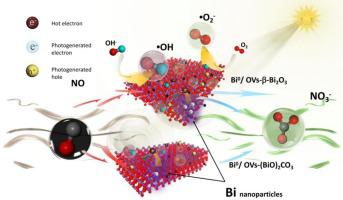Applied Catalysis B: Environment and Energy ( IF 20.2 ) Pub Date : 2020-08-28 , DOI: 10.1016/j.apcatb.2020.119481 Fei Rao , Gangqiang Zhu , Weibin Zhang , Jianzhi Gao , Fuchun Zhang , Yu Huang , Mirabbos Hojamberdiev

|
In this study, a N2-assisted thermal treatment method is proposed for in-situ formation of a series of oxygen vacancies (OVs)-rich Bi0/Bi-based photocatalysts, including OVs-(BiO)2CO3, Bi0/OVs-(BiO)2CO3, Bi0/OVs-(BiO)2CO3/β-Bi2O3, Bi0/OVs-β-Bi2O3, Bi0/OVs-β-Bi2O3/α-Bi2O3 and Bi0/α-Bi2O3. Mechanisms of in-situ formation of Bi0 nanoparticles and generation of OVs in Bi-based photocatalysts are clarified. Apart from their contribution to the effective separation of photogenerated charge carriers and enhancement of light absorption, the effects of Bi0 nanoparticles and OVs on selective photocatalytic oxidation of NO are also investigated. Among the synthesized Bi-based photocatalysts, Bi0/OVs-(BiO)2CO3 shows the best photocatalytic activity and stability for photo-oxidative removal of NO. The systematic study of photocatalytic mechanism demonstrated that the Ohmic contact between OVs-(BiO)2CO3 and Bi0 gradually promote the formation of •O2– and •OH species. It is found that •O2– plays an important role in the photocatalytic NO removal process, while •OH species can effectively inhibit the formation of NO2 during the NO removal process. The new approach demonstrated in this study can be applied for the in-situ formation of wide-solar-spectrum-responsive photocatalysts with efficient photocatalytic activity.
中文翻译:

通过N 2辅助热处理从(BiO)2 CO 3原位产生氧空位和金属铋,以有效地选择性去除光催化NO
在这项研究中,提出了一种N 2辅助热处理方法,用于原位形成一系列富氧空位(OVs)的Bi 0 / Bi基光催化剂,包括OVs-(BiO)2 CO 3,Bi 0 / OVs-(BIO)2 CO 3,铋0 / OVs-(BIO)2 CO 3 /β-Bi系2 ö 3,铋0 / OVS-β-Bi系2 ö 3,铋0 / OVS-β-Bi系2 ø 3 /α-Bi系2 ö 3和Bi 0/α-Bi系2 ö 3。阐明了Bi 0纳米粒子的原位形成机理和OVs的生成机理。除了有助于有效分离光生电荷载流子和增强光吸收外,还研究了Bi 0纳米颗粒和OVs对NO选择性光催化氧化的影响。在合成的Bi基光催化剂中,Bi 0 / OVs-(BiO)2 CO 3表现出最好的光催化活性和对NO进行光氧化去除的稳定性。对光催化机理的系统研究表明,OVs-(BiO)2之间的欧姆接触CO 3和Bi 0逐步推进•的O形成2 -物种和•OH。发现•O 2 –在光催化脱硝过程中起着重要作用,而•OH物种可以在脱NO过程中有效抑制NO 2的形成。在这项研究中证明的新方法可以用于具有有效的光催化活性的宽太阳光谱响应光催化剂的原位形成。











































 京公网安备 11010802027423号
京公网安备 11010802027423号